Being so compact, Bratislava is such an easy city to explore on foot, and the Old Town makes an enjoyable full- or half-day walk.
Start: Michael’s Tower
A good place to start is Michael’s Tower. This is also point zero, where you can see the global distances to cities all around the world under the tower. Climb up five flights, observing the Museum of Arms on the way, and you’ll be rewarded with a great view of the ‘little big city’ as it now calls itself. It’s a magnificent panorama with the castle on one side, contrasting with the bizarre sight of a spaceship landing on the bridge.
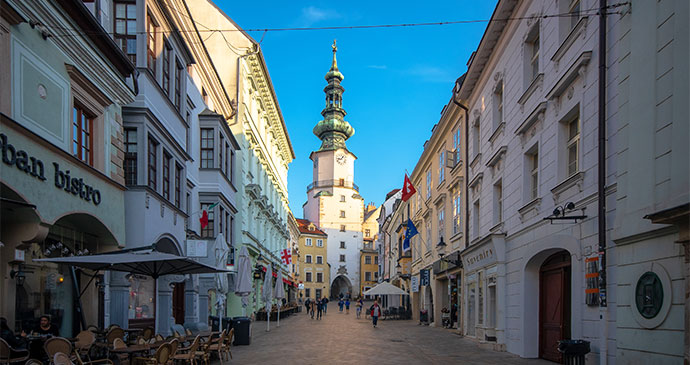
Back down again on the right is Baštová, the narrowest alley in town and, in medieval times, home to the city hangman. For a quick detour, turn right and nip up Klariská and Farská to see the elegant church and convent of the Poor Clares; behind it, Kapitulska is lined with largely disused religious buildings, and has to be the quietest street in the Old Town.
The streets of Michalská and Ventúrska are a continuation of each other and a good introduction to the town, lined with swanky shops and historic buildings. The largest building on Michalská is the former Hungarian Chamber built in 1756, home to sessions of the Diet in the 19th century and now the university library.
A city of palaces
At the point where Michalská and Ventúrska meet you’ll see a big rock with ‘Korzo’ written on it. This signals the start of the korzo or promenade, a custom that continues to this day as families stroll down towards the river in the evening. For a small town, Bratislava is packed with palaces; nearby, at number 15, is the Leopold De Pauli Palace, where Franz Liszt (aged nine) gave a concert in the garden pavilion.
Just opposite is a palace owned by Leopold Pálffy (Ventúrska 10) where Mozart performed for the local aristocracy in 1762, aged six, accompanied by his father. It was the only concert he gave in the then Hungary. Further on at Ventúrska 9, the Zichy Palace was built from 1770 to 1780 on the site of three medieval town houses.
The Universitas Istropolitana, further along at Ventúrska 3, was founded in 1465 by Matthias Corvinus, King of Hungary, and at the time was the only university in Slovakia or Hungary. At Panská 27, the Keglevich Palace was the scene of a concert by Beethoven.
Cathedrals and UFO bridges
Head next for St Martin’s Cathedral, scene of the coronation of 11 Hungarian kings and eight royal spouses. Look out for a gold model of the crown of Szent István, Hungary’s first monarch, on top of the spire.
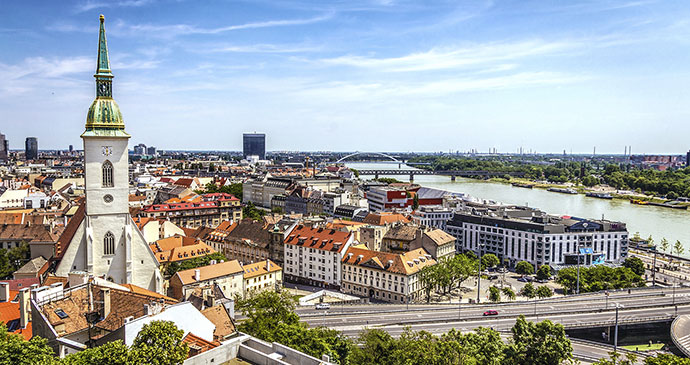
In Rudnayovo námestie there’s a statue in molten metal with a Star of David on the top to commemorate the synagogue that stood here but was demolished to make way for the construction of the Most SNP (then called Nový most – New Bridge) in 1971. Panská (‘Street of the Lords’), now a busy pedestrianised shopping street, is the main east–west route across the Old Town – follow it past the official Pálffy Palace, which holds one of Bratislava’s best galleries.
On Hlavné námestie
Further on, you’ll trip over a man’s head poking out of a manhole – this is Čumil, one of the favourites of all the humorous works of art dotted around town. There are debates as to who he represents – whether a partisan or just a guy who likes to look up skirts. Turning left, you’ll soon be on Hlavné námestie, site of some fine patisseries and perhaps a good place to relax for a while. One of Napoleon’s soldiers can still be found on the square, leaning over the back of a bench, smiling smugly at the city he once tried to destroy.
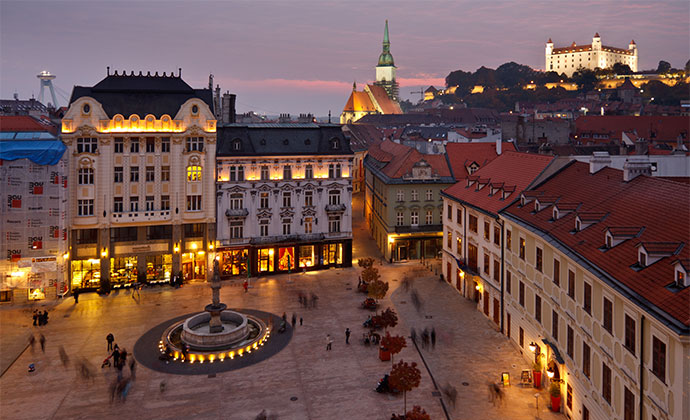
Follow the soldier’s gaze and you arrive at the square’s centrepiece, the Roland Fountain. Roland was a knight who was known as the protector of Bratislava and its citizens, yet the man on the top of the fountain is actually Maximilián II, the first Hungarian king to be crowned in Bratislava. In 1572, after the town was ravaged by fire, Maximilián had the fountain built to provide water in case of future fires. According to a local legend, at midnight on New Year’s Eve Maximilián turns and salutes to all four directions – however, only female virgins can see this.
The red-roofed building with a yellow tower on the east side of the square is the 15th-century Old Town Hall. A cannonball, fired into the city by Napoleon’s army, is embedded in the wall – it’s one often dotted across the Old Town as memorials to then siege of 1809. The barnlike Jesuit church next door was built by the Lutherans in 1638 and on the king’s wish it couldn’t have a tower.
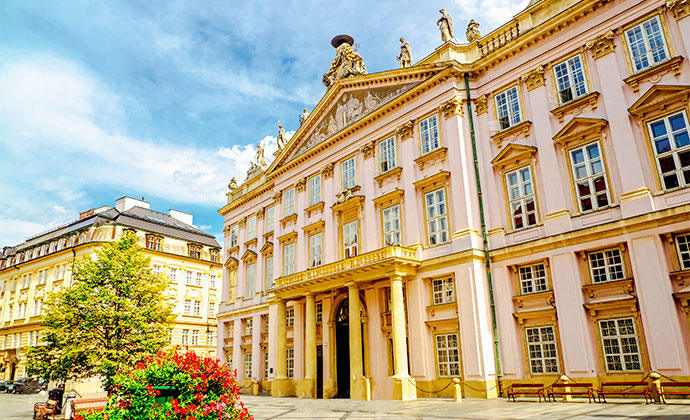
Walk through the Old Town Hall courtyard to Primaciálne námestie where the Primate’s Palace is an explosion of pink and there’s a black cardinal’s hat on the tympanum. It’s also worth going inside to see the hall of mirrors. The House of J N Hummel just up the road celebrates the life of composer Johan Nepomuk Hummel.
Down Hviezdoslavovo námestie
From there it’s a left, right, left southwards through narrow streets and you’ll find yourself on Hviezdoslavovo námestie, a tongue-twisting square lined with trees and dominated by a statue to Pavol Országh Hviezdoslav, the ‘father of Slovak poetry’. On the left is the neo-Renaissance Historical Building of the Slovak National Theatre, home to the opera.
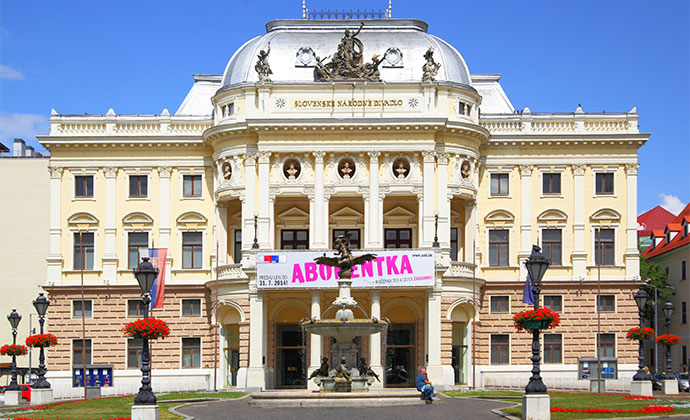
Over the square is the Reduta, home to the Slovak Philharmonic. The huge Buckingham-Palace-like building dominating the square is the Radisson Blu Carlton Hotel and there’s a good restaurant inside. Walk down between the Reduta and the Carlton, passing the bizarre statue to patriot Ľudovít Štúr with figures suspended halfway up a pillar, and you’re out by the Danube.
Cross the road to the embankment and turn left. You’ll pass a statue of a soldier in a trenchcoat holding a machine gun – a Bulgarian war memorial with the message ‘Those who fall in the battle for freedom never die’. Carry on towards the Slovak National Museum, where a statue of the first Czechoslovak president Tomáš Garrigue Masaryk stands tall. It used to be guarded by a statue of a proud lion, commemorating the creation of the Czechoslovak Republic on 28 October 1918 ‘from two brother nations’; however, this was removed to stand guard over the Eurovea Galleria mall.
The icing on the cake
From here, to reach the Blue Church it’s best to cross over the main road, Vajanského nábrežie, by the Slovak National Museum and walk up Kúpeľňa. Take the first right on to Medená and follow the road along to the busy Štúrova thoroughfare. Cross the road and walk along Grösslingova which will lead you to the Blue Church, passing some interesting Art Nouveau buildings en route. Ödön Lechner, ‘father’ of modern Hungarian architecture, designed the church and also the high school at Grösslingova 18, with its light brown and beige colours; during term time you can pop inside and check out the grand staircase in custard and cream, but watch out for the officious school porter.
There are also several doorways with Socialist Realist reliefs of enthusiastic workers. At the first turning right on to Bezručova, an amazing image will come into view: the incredible, almost edible Blue Church, an Art Nouveau building dedicated to St Elizabeth, which looks like it’s covered in blue icing.
Discover more of the city in our comprehensive guide:
